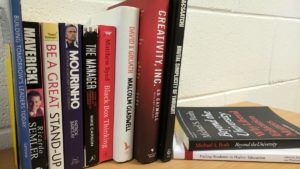
Last night, I was thinking a lot about giving lectures. This is not unusual, but this time it wasn’t the content that interested me, but the mechanics of lecturing.
Three things happened over the past two days which brought this to the forefront of my mind. First, I’d come back from a fantastic 2-day leadership development residential; second, I’d just given four hours straight teaching, and; third, I’d just watched Jerry before Seinfeld.
The leadership workshop was great. Run by the Leadership Foundation for HE and facilitated by Doug Parkin, it was two days of valuable reflection and discussion on how to be an effective leader in universities. I really enjoyed it, and enjoyed having the space to think about this issue and be challenged on how I approach leading my portfolio. I’m hopeful my colleagues will notice the difference…
The four hours of teaching consisted of two, 2-hour lecture sessions (back to back) for our forensic science and biology final years. Two hours on the nature of forensic anthropology, and two hours on medium-to-long term changes to the body after death. It was great fun, the students got stuck in; but it was exhausting.
Netflix is great. And I love the amount of stand-up on it. I love stand-up comedy. Not just because it’s funny, but also because of the craft and skill involved in being funny. Seinfeld is one of my favourites: his TV series still holds up and still remains eminently quotable, while his web series Comedians in Cars Getting Coffee is well worth a look. Don’t tell my boss, but I sometimes have it on in the background while doing more mindless tasks. Jerry before Seinfeld started slow, but when he hits hit stride, it was really funny. Rather than a show about nothing, it’s a show about becoming a comedian.
Now, while I’m sure you find this window into my Thursday evening just fascinating, you’re probably asking what any of this has got to do with lecturing. Clear your minds then. Imagine you’re not long out of a PhD and into your first academic post. You’ve got to lecture, but no-one has actually thought to teach you how to lecture. What do you do? Well, you can look for advice. Which is what I did. I turned to books written for academics to help with lecturing, but found them all to be useless. They either stated the blindingly obvious, or didn’t state anything at all! So, as is frankly the hallmark of my career, I looked to steal ideas from other disciplines.
The thing about academic posts, is that you get them for being good in your chosen discipline. And generally the skills required to drive a three-year doctoral project and publish the results through peer review, are not the same skills as those that make a good teacher. And this isn’t acknowledged enough. It’s really really hard to give a lecture. It takes a huge amount of confidence to stand up in front of 150 people, all of whom are judging you from your accent to your clothes to your slides, and talk for an hour, or two. If you went up to a person on the street and asked them to do that, they’d run a mile. How many students, when asked to give a 10 minute presentation for which they’ve been prepping for for four weeks, still come out in a cold sweat and start shaking. Some even faint. And quite right – it’s terrifying. I realised when doing my PhD that it wasn’t giving me the skills I needed to lecture (also, as hard as it is to believe now, back then I was a shy introvert and not the raging show-off you see before you today) so I took my teaching certificate at the same time. And as useful as that was, it still didn’t teach me how to stand up in front of a group of strangers and talk. So what to do?
Think about it. Which job is most similar to lecturing? Which other job requires you to stand up in front of strangers, talk for an hour, hold their interest, command a stage, deal with hecklers and be judged on what you say and how you say it. Stand up. The most useful book I have ever read to help me with my lecturing is ‘Teach Yourself Be a Great Stand-Up’. When I tell people this, they usually think that it’s a book filled with jokes. It’s not (turns out, I’m naturally hilarious…). It’s a book about how to craft and build a set (lecture) and how you can be engaging and yet still tell a story. It helps you appreciate that the audience connects with you, not the content, and that you need to stand up and tell a story. I’ve said before in previous presentations that the best way for people to connect with research is to humanise the research and the researcher. This book gave me the confidence to do that in the lecture theatre.

It also made me realise that it was alright to try ‘new material’ and to not worry if it didn’t hit. You just go back, rework it, and try again. For me though, the best stand up is a conversation between the comic and the audience. Again, this is what I go for, although it’s not always successful. I want to chat. I want to talk about my subject. And this brings me back to the leadership course I went on. One key point we discussed is that leaders don’t need to be inspiring, they need to be inspired. Here we can take this to mean by our disciplines.
I don’t remember a huge number of my lectures from my undergrad and postgrad days, but I do remember a couple of bad ones. The lecturer clearly couldn’t be arsed and the material was given in such a boring manner. When I’m lecturing, I’m trying to convince the class that my subject is the most interesting there is. To be fair, I have a clear advantage over my School colleagues in that I actually do study the most interesting subject. I’ve told them this. To their faces. I hope that enthusiasm comes across in my teaching sessions. And I can say from experience that a room full of students will forgive a lot, if you’re happy to be there and excited to talk about your subject.
In the show, Jerry (I think we’d be on first name terms…) notes that being a comedian is the sort of job that everyone thinks they can do, if only they had the opportunity. I’m pretty sure I couldn’t. I think being privileged enough to talk about whatever I want in front of a room full of people, who are taking on board what I’m saying, and taking part in that conversation, is as close as I’ll get. Not that there’s anything wrong with that…